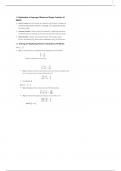1.1. Explanation of Improper, Mixed, and Proper Fractions (6
Marks)
Proper Fraction: A fraction where the numerator (top number) is smaller than
the denominator (bottom number). For example, }. This shows that we have
less than a whole.
Improper Fraction: A fraction where the numerator is larger than or equal to
the denominator. For example, • This means we have more than one whole.
Mixed Fraction: A fraction that includes a whole number and a proper
fraction. For example, 24, which means 2 whole parts and 4 of another part.
1.2. Solving and Explaining Fraction Calculations (18 Marks)
121.4:
Step 1: Change division to multiplication by flipping the second fraction:
4 6
9 X 12
tiply the numerators and the den
46 24
9 X 12 108
Step 3: Simplify the fraction by dividing both the numerator and denominator
by their greatest common factor (GCF), which is 12:
24:12 2
108 + 12 9
• Final Answer. t
1.22.x%
• Step 1 Multiply all the numerators and all the denominators:
12 X 9x5 540
6x5x4 120
• Step 2 Simplify the fraction by dividing by the GCF, which is 60
540 : 60 9
120: 60 2
Answer. { or 4}
, 123.j+{
Step 1: Convert into a whole number:
8
- -2
4
• Step 2: Make the denominators the same (LCD of 17 and 1is 17)
5 34 5+34 39
mm
• Step 3: Convert the improper fraction {l to a mixed fraction:
39:17 -2R5 =
• Final Answer.2
1.3. Fractions, Decimals, and Percentages Relationship (6
Marks)
Fractions to Decimals: To convert a fraction to a decimal, divide the
numerator by the denominator. For example, 5 is:
V
2:30.666... (repeating)
Fractions, decimals, and percentages are all ways to represent parts of a whole.
• Fractions to Decimals: To convert a fraction to a decimal, divide the
numerator by the denominator. For example, f is:
2 + 3 - 0.666.. (repeating)
ractions to Percentages: To convert a fraction to a percentage, multiply the
fraction by 100. For #:
2
x100 -- 66.66%
Two examples:
=0.5(decimal) = 50% (percentage)
}=025(decimal) = 25% (percentage)




